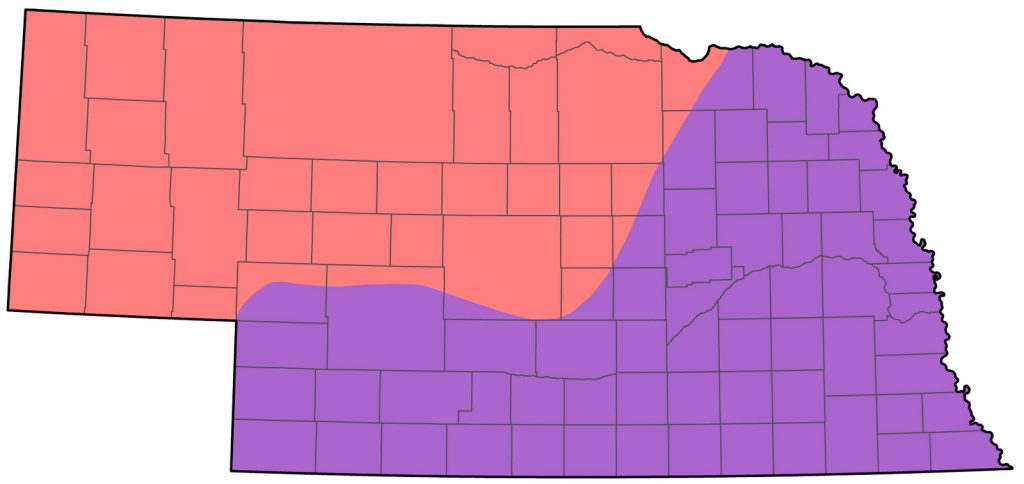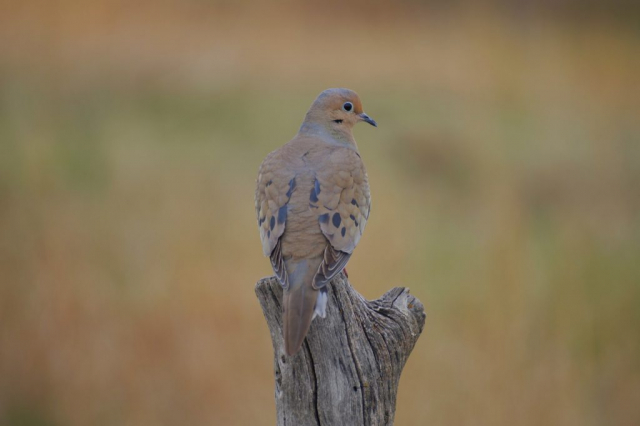Zenaida macroura marginella
Status: Abundant regular spring and fall migrant statewide. Common regular breeder statewide. Uncommon regular winter visitor south and east, rare north and North Platte River Valley, rare casual elsewhere in Panhandle.

Documentation: Specimen: UNSM 6232, 30 May 1914 Haigler, Dundy Co.
Taxonomy: Five subspecies are recognized (AviList 2025), two occupying North America north of Mexico: marginella breeds in the western USA from British Columbia to south-central Mexico and east to Minnesota and Arkansas (AOU 1957), and carolinensis breeds in the eastern USA east of marginella, south to Bermuda and the Bahama Islands.
Rapp et al (1958) list marginella as the subspecies occurring in Nebraska, although Otis et al (2020) show the zone of overlap of the two subspecies to include extreme southeast Nebraska. It is likely that darker-plumaged eastern subspecies carolinensis and intergrades occur in eastern Nebraska during migration periods.
See the Eurasian Collared-Dove x Mourning Dove for putative hybrids with Eurasian Collared-Dove.
Spring: Feb 11, 11, 12 <<<>>> summer (north, west)
Only in the north and west is this species essentially absent in winter (see Winter). In those areas, spring arrival is generally in early Mar. An indication of the build-up in numbers in spring in the north were total counts by month in 2018 in Cherry Co of 9, 81, and 198 for Mar, Apr, and May respectively (James Ducey, personal communication).
- High counts: 200 at Redbird WMA, Holt Co 5 May 2024, 125 at Rock Creek SRA, Dundy Co 2 May 2021, 100 near Crawford, Dawes Co 18 May 2018, and 100 at Box Butte Reservoir SRA, Dawes Co 23 Apr 2024.
Summer: Breeding densities are uniform over most the state, although lowest in the Panhandle (Sauer et al 2017). BBS trend analysis shows numbers have been relatively stable from 1966-2015, but with regional declines in the southeast and increases >1.5% per year in the west. One of the most numerous species reported on BBS routes, routes in the north, south, and east average 79.7 birds per route, and those in the Panhandle 50.7 birds per route.
-
- Breeding Phenology:
Nest building: 25 Mar-16 Aug
Eggs: 27 Mar- 17 Sep (Mollhoff 2022)
Egg-shell fragments (fresh): 29 Mar - Nestlings: 4-9 Jun
Fledged young: 14 Apr-24 Jul - Mourning Doves may raise as many as five broods per year Apr-Sep in Nebraska (Traylor 1991) and up to six in Texas (Otis et al 2020). A flock of 50-75 birds near Gering, Scotts Bluff Co 26 May 2003 probably consisted mostly of newly fledged birds.
- Breeding Phenology:
Fall: summer <<<>>> Nov 13, 14, 14 (north and west, west of Boone and Antelope Cos, away from North Platte River Valley)
Juveniles from early broods may begin migration as early as Jul, but adults generally molt before departure (Traylor 1991). Jul flocks can be large: 300 were in Dawson Co 29 Jul 2001, 257 at Lincoln Saline Wetlands NP, Lancaster Co 15 Jul 2025, and 245 in two flocks in Cass Co 11 Jul 2000. Peak migration occurs around 1 Sep (see High Counts).
Departure in the north and west is generally completed by mid-Nov; see Winter for later reports.
In the southeast many remain into Dec, as indicated by CBC data; highest CBC counts are 339 at Lincoln in 1979, 303 there in 1978, and 244 there in 1970. Birds per party-hour for the east are 0.725, south 0.222, north 0.023, and west 0.038.
Most Mourning Doves banded in Nebraska move directly south as far as Mexico (see Comments).
- High counts: 4000+ in Cherry Co 1 Sep 2007, 1000 in Omaha 24 Aug 2000, 796 at Fremont Lakes SRA, Dodge Co 26 Sep 2019, 700 in Dawes Co 5 Sep 2015, “several hundred” in south-central counties 21 Sep 2002, and “hundreds” in Franklin Co 26 Aug 2012.
Winter: There are about 33 midwinter (15 Nov-10 Feb) reports for the north and west, west of Boone and Antelope Cos and away from North Platte River Valley.
-
- High counts (11 Nov-12 Feb): 200 at Offutt AFB Lake, Sarpy Co 2 Jan 2014, 200 in a Sarpy Co flock 29 Dec 2023, 175 at Marsh Wren Community Wetlands, Lancaster Co 17 Nov 2019, and 170 at University of Nebraska East Campus, Lancaster Co 15 Dec 2025.
Comments: From 2003 through 2019, 20,101 Mourning Doves of all ages were banded in Nebraska, with 552 recoveries (Fowler 2020). Of these 552 recoveries, 421 were in Nebraska, and 116 in Kansas, Oklahoma, Texas, and Mexico. Only six were recovered elsewhere, including one in Guatemala. A summary of hatch year Mourning Doves banded in Nebraska found that 43.6% were recovered in Texas and 44.4% in Mexico (Traylor 1991).
Images
Abbreviations
BBS: Breeding Bird Survey
CBC: Christmas Bird Count
UNSM: University of Nebraska State Museum
Literature Cited
American Ornithologists’ Union [AOU]. 1957. The AOU Check-list of North American birds, 5th ed. Port City Press, Baltimore, Maryland, USA.
AviList Core Team, 2025. AviList: The Global Avian Checklist, v2025. https://doi.org/10.2173/avilist.v2025.
Fowler, E. 2020. Nebraskaland Magazine, Nov 2020. Nebraska Game and Parks Commission, Lincoln, Nebraska. http://magazine.outdoornebraska.gov/2020/07/dove-banding/.
Mollhoff, W.J. 2022. Nest records of Nebraska birds. Nebraska Ornithologists’ Union Occasional Paper Number 9.
Otis, D.L., J.H. Schulz, D. Miller, R.E. Mirarchi, and T.S. Baskett. 2020. Mourning Dove (Zenaida macroura), version 1.0. In Birds of the World (A. F. Poole, Editor). Cornell Lab of Ornithology, Ithaca, NY, USA. https://doi.org/10.2173/bow.moudov.01
Rapp, W.F. Jr., J.L.C. Rapp, H.E. Baumgarten, and R.A. Moser. 1958. Revised checklist of Nebraska birds. Occasional Papers 5, Nebraska Ornithologists’ Union. Crete, Nebraska, USA.
Sauer, J.R., D.K. Niven, J.E. Hines, D.J. Ziolkowski, Jr, K.L. Pardieck, J.E. Fallon, and W.A. Link. 2017. The North American Breeding Bird Survey, Results and Analysis 1966 – 2015 (Nebraska). Version 2.07. USGS Patuxent Wildlife Research Center, Laurel, Maryland, USA.
Traylor, S. 1991. Weather keeps dove numbers up for opener. Omaha World Herald, 29 Aug 1991.
Recommended Citation
Silcock, W.R., and J.G. Jorgensen. 2025. Mourning Dove (Zenaida macroura). In Birds of Nebraska — Online. www.BirdsofNebraska.org
Birds of Nebraska – Online
Updated 20 Aug 2025

